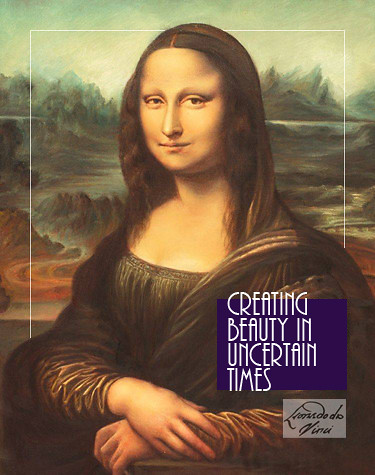
Volume XX, Issue IX: Creating Beauty in Uncertain Times
Leonardo da Vinci's Uncertain Times
The Renaissance is often pointed to as a time when learning and creativity flourished. Certainly these were a great time to be alive if you were an artist – or where they? Milan was surely a place at a crossroads, where art and culture came into their own, but it must be noted that the government of the Italian City-states was certainly not as wonderful as we might imagine. Ludovico Maria Sforza, the Duke of Milan, sought to present himself as a grand leader but he ultimately was deposed by Louis XII of France. The leadership of Renaissance City Sates was anything but dependable.
Leonardo di ser Piero da Vinci came to Milan to make his fortune. The illegitimate son of a Florentine notary, young Leonardo was denied the advantage of a Classical education. His father, Piero da Vinci, did not entirely abandon his son, apprenticing him to Florentine painter Andrea del Verrocchio. Actually Verrocchio was a painter, sculptor, architect and a goldsmith as well. Painters in the day would be admitted into the Guild of St. Luke, which included both painters and physicians. The world was open to polymaths. Leonardo would seize on this opportunity – but the world of Florence offered little opportunity to an illegitimate child with no education so Leonardo wrote to Sforza offering his services as a military engineer. The sentiment expressed in Matthew 13:57 has driven many a young person to pick up stakes. This was true of Leonardo. Like so many who live “without honor in their own country” he found commissions in Milan that stretched his abilities. Sforza obtained the commission for “The Last Supper” to grace the refectory of the Convent of Santa Maria delle Grazie. Unfortunately this beautiful mural was one of Leonardo’s first experiments with oils as opposed to the normal fresco methods. Sadly, the moisture in the wall flaked off about 80% of this masterwork.
Leonardo da Vinci would survive a wave of pandemic as the bubonic plague ravaged Milan in 1484 and 1485. A full third of the city’s population, some 50,000 people, were killed by the pestilence. Da Vinci noted that the medieval cities such as Milan, which had been built tight together for defense, were dirty, crowded, dark and most conductive to the spread of disease. He engaged in an exercise in city planning, proposing a more open and modern layout with canals and taller mixed use buildings spaced to allow for the admission of light and fresh air. Commerce would occupy the lower levels, with underground passageways for freight which would arrive by canal. Pedestrians would enjoy the space above and dwellings would be placed on the upper floors. Addressing separation and sanitation, Leonardo truly envisioned modern urban planning.
Ludovico wanted a great equestrian monument to himself and Leonardo prepared to cast the gigantic steed that he would be seated on in 1499. He built the clay model after sketching numerous horses in the duke’s stables. Unfortunately the war required that the bronze for the statue be diverted to manufacture cannons instead. Eventually invading mercenaries used the great clay model for target practice. “Il Gran Cavallo” would not be realized until 500 years later. In 1999 Sculptor Nina Akamu actually cast the fifteen ton bronze horse, which is now standing in Milan. Leonardo, upon the fall of Sforza, fled to Venice, then returned to Florence. In 1502 Leonardo entered the service of Cesare Borgia, the son of Pope Alexander VI. Leonardo served Borgia as a military architect, drawing up detailed maps and plans. Cesare Borgia was a ruthless ruler and warrier, becoming the model for Machiavelli’s Prince. Leonardo left his service and returned to Florence in 1503.
In 1506 Charles II d’Amboise, the acting French governor of Milan called Leonardo back to that city. Here Leonardo had a number of student/apprentices working in his studio and was able to devote himself to his scientific interests. When an alliance of Swiss, Spanish and Venetian troops drove the French from Milan, Leonardo stayed on in the villa of Vaprio d’Adda owned by the Medicis. When Lorenzo de Medici’s son Giovanni became Pope Leo X, Leonardo went to Rome but he did not remain in the Pope’s favor. Michelangelo and Raphael scored the big commissions. In 1516 Leonardo entered the service of Francis I of France who had recaptured Milan the year before. He was provided with a manor house, the Château du Clos Lucé, just below the king’s Château d'Amboise. Here he would spend his final days, partially disabled by a stroke. At his death, the painting known as Mona Lisa came into the hands of the French king. When exactly it was painted and of whom remains a much discussed mystery but the painting itself represents a triumph of study and technique for a master who’s life was lived in such times of turmoil.
